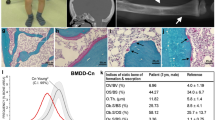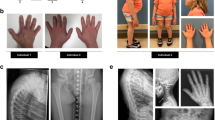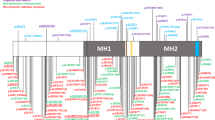Abstract
Craniometaphyseal dysplasia (CMD) is a bone dysplasia characterized by overgrowth and sclerosis of the craniofacial bones and abnormal modeling of the metaphyses of the tubular bones. Hyperostosis and sclerosis of the skull may lead to cranial nerve compressions resulting in hearing loss and facial palsy1,2. An autosomal dominant form of the disorder (MIM 123000) was linked to chromosome 5p15.2–p14.1 (ref. 3) within a region harboring the human homolog (ANKH) of the mouse progressive ankylosis (ank) gene4. The ANK protein spans the outer cell membrane and shuttles inorganic pyrophosphate4 (PPi), a major inhibitor of physiologic and pathologic calcification, bone mineralization and bone resorption5. Here we carry out mutation analysis of ANKH, revealing six different mutations in eight of nine families. The mutations predict single amino acid substitutions, deletions or insertions. Using a helix prediction program, we propose for the ANK molecule 12 membrane-spanning helices with an alternate inside/out orientation and a central channel permitting the passage of PPi. The mutations occur at highly conserved amino acid residues presumed to be located in the cytosolic portion of the protein. Our results link the PPi channel ANK with bone formation and remodeling.
This is a preview of subscription content, access via your institution
Access options
Subscribe to this journal
Receive 12 print issues and online access
$209.00 per year
only $17.42 per issue
Buy this article
- Purchase on Springer Link
- Instant access to full article PDF
Prices may be subject to local taxes which are calculated during checkout





Similar content being viewed by others
References
Jackson, W.P.U., Albright, F., Drewery, G., Hanelin, J. & Rubin, M.L. Metaphyseal dysplasia, epiphyseal dysplasia, diaphyseal dysplasia and related conditions. Arch. Intern. Med. 94, 871–885 (1954).
Beighton, P. Craniometaphyseal dysplasia (CMD), autosomal dominant form. J. Med. Genet. 32, 370–374 (1995).
Nürnberg, P. et al. The gene for autosomal dominant craniometaphyseal dysplasia maps to chromosome 5p and is distinct from the growth hormone-receptor gene. Am. J. Hum. Genet. 61, 918–923 (1997).
Ho, A.M., Johnson, M.D. & Kingsley, D.M. Role of the mouse ank gene in control of tissue calcification and arthritis. Science 289, 265–270 (2000).
Fleisch, H. Diphosphonates: history and mechanisms of action. Metab. Bone Dis. Relat. Res. 3, 279–288 (1981).
Hughes, A.E., McGibbon, D., Woodward, E., Dixey, J. & Doherty, M. Localisation of a gene for chondrocalcinosis to chromosome 5p. Hum. Mol. Genet. 4, 1225–1228 (1995).
Andrew, L.J. et al. Refinement of the chromosome 5p locus for familial calcium pyrophosphate dihydrate deposition disease. Am. J. Hum. Genet. 64, 136–145 (1999).
Iughetti, P., Alonso, L.G., Wilcox, W., Alonso, N. & Passos-Bueno, M.R. Mapping of the autosomal recessive (AR) craniometaphyseal dysplasia locus to chromosome region 6q21–22 and confirmation of genetic heterogeneity for mild AR spondylocostal dysplasia. Am. J. Med. Genet. 95, 482–491 (2000).
Hofmann, K. & Stoffel, W. TMbase—a database of membrane spanning protein segments. Biol. Chem. 374, 166 (1993).
Overhauser, J. et al. Molecular and phenotypic mapping of the short arm of chromosome 5: sublocalization of the critical region for the cri-du-chat syndrome. Hum. Mol. Genet. 3, 247–252 (1994).
Tinschert, S. & Braun, H.-S. Craniometaphyseal dysplasia in six generations of a German kindred. Am. J. Med. Genet. 77, 175–181 (1998).
Spranger, J., Paulsen, K. & Lehmann, W. Die kraniometaphysäre Dysplasie (Pyle). Z. Kinderheilkd. 93, 64–79 (1965).
Schwahn, B., Schaper, J., Herkenrath, P., Michel, O. & Schönau, E. Autosomal-dominante kraniometaphysäre dysplasie. Monatsschr. Kinderheilkd. 144, 1073–1077 (1996).
Taylor, D.B. & Sprague, P. Dominant craniometaphyseal dysplasia—a family study over five generations. Australas. Radiol. 33, 84–89 (1989).
Eisenberg, D., Weiss, R.M. & Terwilliger, T.C. The helical hydrophobic moment: a measure of the amphiphilicity of a helix. Nature 299, 371–374 (1982).
Dib, C. et al. A comprehensive genetic map of the human genome based on 5,264 microsatellites. Nature 380, 152–154 (1996).
Chandler, D. et al. Refinement of the chromosome 5p locus for craniometyphyseal dysplasia. Hum. Genet. (in press).
Thompson, J.D., Higgins, D.G. & Gibson, T.J. CLUSTAL W: improving the sensitivity of progressive multiple sequence alignment through sequence weighting, position-specific gap penalties and weight matrix choice. Nucleic Acids Res. 22, 4673–4580 (1994).
Acknowledgements
We thank the patients and their families for cooperation; colleagues of the Universitätskinderklinik Würzburg for permission to publish the radiographs of the patient from family 1; B. Brunner for the total RNAs from different T. nigroviridis tissues; and P.N. Robinson for critical reading of the manuscript. H.T. is supported by a scholarship from the Research Commission of the Charité. N.L. is supported by Australian National Health and Medical Research Council project grant 970104. D.C. was supported by the Centre for Human Genetics, Edith Cowan University.
Author information
Authors and Affiliations
Corresponding author
Supplementary information
Rights and permissions
About this article
Cite this article
Nürnberg, P., Thiele, H., Chandler, D. et al. Heterozygous mutations in ANKH, the human ortholog of the mouse progressive ankylosis gene, result in craniometaphyseal dysplasia. Nat Genet 28, 37–41 (2001). https://doi.org/10.1038/ng0501-37
Received:
Accepted:
Issue Date:
DOI: https://doi.org/10.1038/ng0501-37
This article is cited by
-
A new perspective on intervertebral disc calcification—from bench to bedside
Bone Research (2024)
-
Skeletal phenotypes in secreted frizzled-related protein 4 gene knockout mice mimic skeletal architectural abnormalities in subjects with Pyle’s disease from SFRP4 mutations
Bone Research (2023)
-
Role of the extracellular ATP/pyrophosphate metabolism cycle in vascular calcification
Purinergic Signalling (2023)
-
Activation of nuclear factor-kappa B accelerates vascular calcification by inhibiting ankylosis protein homolog expression
Kidney International (2012)



